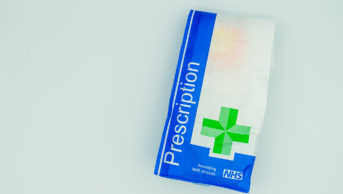
Mclean/Shutterstock.com
In November 2018, it became legal for specialist doctors in the UK to prescribe medical cannabis. The move followed several high-profile cases of young children with severe epilepsy whose parents were desperate to obtain the drug, but unable to do so legally.
However, only a handful of patients have received cannabis prescriptions in the past year. In draft guidance, published in August 2019, the National Institute for Health and Care Excellence (NICE) said that more research is needed as current evidence is “limited and of low quality”, and clinical trials have shown a high level of adverse events.
Published at the same time, a report commissioned by NHS England and NHS Improvement, published in August 2019, concluded that if cannabis-based medical products “are to be routinely commissioned across the NHS, the science and the evidence base supporting use needs to be significantly better developed”.
Currently, the strongest evidence for use of medical cannabis is for treatment of intractable seizures in two severe forms of childhood epilepsy, Dravet and Lennox-Gastaut syndromes; chemotherapy-induced nausea and vomiting; controlling spasticity in multiple sclerosis; and for managing chronic pain.
It is estimated that 1 million people in the UK currently self-medicate with cannabis for a variety of conditions
But there are many more conditions for which patients believe cannabis can help. It is estimated that 1 million people in the UK currently self-medicate with cannabis for a variety of conditions[1]
. However, while this has produced anecdotal evidence that cannabis is beneficial in a range of illnesses, it has provided little in the way of robust data.
In recent years, researchers have been investigating the efficacy of medical cannabis for several mental or behavioural disorders. A meta-analysis published in The Lancet Psychiatry in October 2019 suggests that using cannabinoids to treat six mental health conditions — depression, anxiety disorders, attention-deficit hyperactivity disorder (ADHD), Tourette’s syndrome, post-traumatic stress disorder (PTSD) and psychosis — cannot be justified based on the current evidence, although most studies used pharmaceutical cannabinoids, rather than medical cannabis. The study authors call for urgent randomised controlled trials to determine whether there are benefits for these indications[2]
.
PTSD, schizophrenia and ADHD are three emerging areas in which medical cannabis is starting to show some promising results, although evidence is still limited and further robust trials are desperately needed.
Post-traumatic stress disorder
As a practising internal medicine doctor in the United States, Sue Sisley only began paying attention to medical cannabis when what her patients were telling her about its benefits for PTSD became too hard to ignore.
“There’s a mountain of anecdotal evidence that was accumulating from my own patients and I realised the medicines that I was prescribing weren’t doing the job,” says Sisley. “At that point, I agreed that we owed it to them to study the plant in a rigorous and controlled environment. That’s when I started working on the clinical trials.”
Now president and principal investigator at the Scottsdale Research Institute in Phoenix, Arizona, Sisley has completed a phase II randomised controlled trial of smoked cannabis flower in veterans with PTSD and hopes to publish the results later in 2019.
She is also attempting to put the cannabis flower through the US Food and Drug Administration (FDA) drug approval process. It would be a first for the agency, which has never approved a botanical product.
“It is a new experience for the FDA to work with botanical medicine. We’re trying to persuade it that, [even though the cannabis plant is] green and leafy, it’s still a medicine,” says Sisley.
Many researchers believe there is an “entourage effect” at play when cannabis is used medicinally, whereby its many constituents — including more than 100 known cannabinoids — interact in a complex way.
The beauty of the cannabis plant is that it’s so complex. There are hundreds of different cannabinoids, terpenoids and flavonoids, all working together synergistically
“We’ve all been brainwashed by big pharma to believe in the standard model: [there’s] one molecule for one receptor,” says Sisley.
“The beauty of the cannabis plant is that it’s so complex. There are hundreds of different cannabinoids, terpenoids and flavonoids, all working together synergistically.
“For the FDA, that’s a different paradigm and we have to bring [the agency] along.”
Sisley feels strongly that it is important to study the cannabis flower rather than extracts or derivatives, such as oils or purified cannabidiol (CBD). “I try to focus our work only on [the] flower — smoked and vaporised — because I believe that that’s where the real medicine is, and all these other extracts are just sub-optimal derivatives,” she says.
“Even in the best extractor’s hands, you’re not going to be able to maintain all of the constituents in the natural flower, so we don’t know what molecules are clinically beneficial.”
Sisley says that, while cannabis may not appeal to drug companies because of its lack of patentability, insurance companies could be willing to fund it if it works as an alternative to other, more expensive, pharmaceutical options[3]
.
“Being on all these prescriptions tends to [become] demoralising. Cannabis can empower people to safely get off other prescriptions that were addictive or never needed.
“Ultimately, insurance companies may agree to that even before FDA approval, because they may realise that it has [the] potential to save them a lot of money.”
Currently, most patients start taking cannabis after conventional treatments have failed, but Sisley says she sees no reason why cannabis could not be used first line in future if the evidence emerges to support it.
A 2019 systematic review carried out by researchers at UCL found that cannabinoids may hold promise as a treatment for PTSD, in particular for reducing nightmares and helping people to sleep, although the underlying mechanism is not yet understood[4]
.
However, the researchers described the lack of evidence supporting cannabis as a PTSD treatment as “striking” given the vast interest in it and the unmet need for better PTSD treatments. They said that well-controlled, randomised, double-blind clinical trials were “highly warranted”.
Schizophrenia
Recreational cannabis use has been associated with an increased risk of developing mental health disorders, including psychosis, depression and anxiety[5]
,[6]
. But, conversely, some evidence is now surfacing that shows that cannabis could be used to treat the very conditions it has been credited with triggering.
The answer lies in breaking down the effects of the different components within cannabis, which contains up to 144 different cannabinoids.
The damaging effects of cannabis use on mental health have been discovered to be largely dependent on delta-9-tetrahydrocannabinol (THC), its main psychoactive component, which, in experimental studies, has been found to produce short-term and dose-dependent psychotic symptoms and impaired memory[5]
,[7]
.
However, the other most widely studied cannabinoid, CBD, works in direct opposition to THC and, consequently, the effects of cannabis on the user depend on the balance between the two.
For example, street varieties of cannabis, such as skunk, contain virtually no CBD to temper the effects of THC, and these have been strongly linked to a risk of psychosis[7]
.
“In general, if you look at the effect of THC and CBD on brain activity, they seem to be pushing in opposite directions in the same region of the brain,” explains Philip McGuire, an expert in psychiatry and cognitive neuroscience based at King‘s College London.
“So if THC makes one region of the brain more active, CBD will do the opposite, and vice versa.”
This, he explains, led researchers to believe that CBD may actually be antipsychotic.
In schizophrenia, there is a need for additional treatments. The mainstay antipsychotic drugs, which target the dopaminergic system, were developed in the 1950s. These can be powerful, but also have their limitations, including a high prevalence of side effects, which can include weight gain, sexual dysfunction, Parkinsonism and myocarditis. Plus, some patients simply do not respond to them.
Since these drugs were developed, the endocannabinoid system within the brain, which is less well known than its serotonergic and dopaminergic cousins, was discovered.
McGuire’s team has carried out two trials exploring the therapeutic potential of CBD in patients with schizophrenia. One of these, involving 88 patients, found a decreased rate of psychotic symptoms in those treated with CBD compared with placebo alongside their antipsychotic medicines, but a comparable adverse event rate between the two groups[8]
.
The other study explored whether CBD can help to protect people who are at risk of developing the condition. This trial has been completed and publication of the results is expected soon.
If CBD becomes an accepted therapy in schizophrenia, it could lead to a whole new class of drugs
A research team in Germany has published findings comparing CBD to the antipsychotic drug, amisulpride, and found that it was able to reduce psychotic symptoms in acute schizophrenia just as effectively but with fewer side effects[9]
.
If CBD becomes an accepted therapy in schizophrenia, it could lead to a whole new class of drugs. “There [are] several kinds of plausible biological mechanisms by which it could work. But the issue is that we don’t know which one of these potential mechanisms is the relevant one [for psychosis],” explains McGuire.
However, incorporating neuroimaging into trials of CBD in schizophrenia should shed light on this mechanism, he says.
“If we understood how it worked, then [we would have] a new therapeutic target for psychosis and the industry could develop other drugs that could act on that same system.
“So it’s really important to try and understand the mechanism as well as just showing that it works.”
McGuire adds that despite the promising results, larger trials are needed — some of which are already under way, with results expected in the next few years. He therefore advises would-be prescribers to be cautious about diving in too soon.
“I think CBD has huge potential, but we have to resist the temptation to start prescribing it before we really know for sure,” he concludes.
Attention deficit hyperactivity disorder
For Philip Asherson, an expert in adult ADHD, his interest in medical cannabis began with a single patient.
“He came along with his mother, and his mother said the only time you could have a proper conversation with him was when he’d had some cannabis,” Asherson explains.
“Otherwise, he was just so disorganised and distracted, she couldn’t even talk to him.
“So I was kind of struck by that. And then I wondered, could we replace his use of street cannabis with a prescribed drug like Sativex?”
The result was a very expensive one-person trial.
“It worked quite well,” says Asherson. “The only problem was, he seemed to need to use a lot of it… Potentially it could have helped him, but it was far too costly.”
This was when Asherson and his colleagues approached the drug’s manufacturer, GW Pharmaceuticals, to ask if it would provide the drugs and placebos to carry out a small trial.
The small six-week study involved 30 participants with ADHD who were randomly assigned to either Sativex oromucosal spray or placebo[10]
. Sativex, a treatment that was developed and licensed for spasticity in multiple sclerosis, contains a 1:1 ratio of THC to CBD.
The findings suggested that Sativex had a magnitude of effects on ADHD symptoms and cognitive performance similar to existing drugs, says Asherson. The reduction in the Conners’ Adult ADHD Rating Scale score for Sativex versus placebo was estimated at 2–3 points for symptoms of inattention and hyperactivity/impulsivity compared with 3–4 in a recent study of stimulant medication, the researchers report[11]
.
As in psychosis, the effects of cannabis in ADHD are thought to be related to the dopaminergic system. It is thought that people with the condition have a lack of dopamine within their brains and some of the existing treatments target this system[11]
.
While there is some excitement around the use of cannabis and cannabinoids in ADHD, it is still very early days
In its most severe forms, people with ADHD experience symptoms that can hugely impair their ability to take part in everyday life. This includes restlessness, mind-wandering, an inability to relax or concentrate, as well as emotional instability. Asherson’s experience is that, before diagnosis, many will have already turned to street drugs in search of relief.
“A lot of people are using cannabis to particularly help the hyperactivity, the physical restlessness,” says Asherson.
“People feel more patient and some of them said that they’re a lot calmer. Whether it helps attention is less clear to me.”
Asherson says that while there is some excitement around the use of cannabis and cannabinoids in ADHD, it is still very early days and more research is vital to draw any concrete conclusions. Its use is perhaps more contentious than a condition such as childhood epilepsy, he concedes, because there are already effective treatments available. However, he says it could provide an option in future for patients who do not respond or experience intolerable side effects with these treatments.
References
[1] House of Commons Health and Social Care Committee. 2019. Available at: https://publications.parliament.uk/pa/cm201719/cmselect/cmhealth/1821/1821.pdf (accessed October 2019)
[2] Black N, Stockings E, Campbell G et al. Lancet Psych 2019; In press. doi: 10.1016/S2215-0366(19)30401-8
[3] Casarett D & Abrams D. Am J Bioethics 2019;19(4):8–10. doi: 10.1080/15265161.2019.1567193
[4] Hindocha C, Cousijn J, Rall M et al. J Dual Diagnos 2019. doi: 10.1080/15504263.2019.1652380
[5] Di Forti M, Quattrone D, Freeman T et al. Lancet Psych 2019;427–436. doi: 10.1016/S2215-0366(19)30048-3
[6] Patton G, Coffey C, Carlin J et al. BMJ 2002;325. doi: 10.1136/bmj.325.7374.1195
[7] Di Forti M, Morgan C, Dazzan P et al. Br J Psych 2009;195(6):488–491. doi: 10.1192/bjp.bp.109.064220
[8] McGuire P, Robson P, Cubala W et al. Am J Psych 2018;175(3):225–231. doi: 10.1176/appi.ajp.2017.17030325
[9] Leweke F, Piomelli D, Pahlisch M et al. Transl Psych 2012;2:e94. doi: 10.1038/tp.2012.15
[10] Cooper R, Williams E, Seegobin S et al. Eur Neuropsychopharm 2017;27(8):795–808. doi: 10.1016/j.euroneuro.2017.05.005
[11] Sharma A & Couture J. Ann Pharmacother 2014;48(2):209–225. doi: 10.1177/1060028013510699


